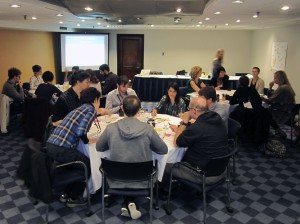The Data Science Environment (DSE) Summit took place in beautiful Monterey, CA at the Asilomar Conference Center. The Summit brought together over a hundred participants across three universities (UW, UC Berkeley and NYU) involved in the Moore and Sloan Foundations’ Data Science Environment grant.
As a data science ethnographer, I typically take on the role of participant-observer of various data science events, but at the DSE Summit I ended up being more of a participant than an observer. The high degree of participation made it challenging at times to listen as closely as I would have wanted to for underlying rhythms and patterns across the group. However participating in the discussion sessions and interactions I identified some important undercurrents. I draw out these undercurrents into two main themes that I discuss in this post.

Photo credit: Kevin Koy
Imagining a Data Science Environment
I participated in particular sessions, including teaching and curriculum development, data science ethnography, and the ethnography and evaluation working group, which were all, to some degree, imagining a data science environment. Underlying these discussions were questions of where and what exactly is data science? Where is it located and when does it matter? What are the origins and the goals? These questions bubbled up in conversations imagining a curriculum for data science, career paths in data science, and the very structuring of a data science community within academia. As these various concepts were discussed and imagined, there was a fracturing and multiplication of perspectives around these questions that sparked a bit of confusion.
There was some clear discomfort with the uncertainty and messiness around these issues. Many people seemed to be craving concrete definitions and the move towards formalization of data science, while others seemed content to not know their specific position or where the ship was headed exactly, opening themselves up to being influenced by the experimentation yet to come. Allowing ourselves as a community to sit with the uncertainty and messiness while we try things out and wrap our heads around the implications is very much part of the goal of these five years. As an ethnographer, I am drawn to messiness, so I was feeling quite comfortable in these conversations.
I am going to attempt to disentangle a few strands of conversation in the unconference session on data science ethnography which focused on different approaches to data science. This discussion drew on a previous conversation about how different ways of approaching data science can emphasize a more individual-oriented view versus a community-oriented view. This conversation helped shift the focus from data science as residing within an individual to data science enacted at the community level.
This included thinking through the implications of different metaphors, such as T to pi (Π) to gamma ( ) for characterizing the shape of data scientists of the future. The shape of a pi-shaped scientist implies there is an expectation of individuals having expert-level depth of knowledge in two domains. Whereas a gamma-shaped scientist would have expert-level depth in one domain and be versed and proficient in another domain. The addition of other metaphors, such as gamma-shaped individuals, expands our imagination for what this data science environment might look like. It also has implications for how people may or may not identify as data scientists or as playing various roles within the data science community. This gets at the heart of the question, “What are we building?”
) for characterizing the shape of data scientists of the future. The shape of a pi-shaped scientist implies there is an expectation of individuals having expert-level depth of knowledge in two domains. Whereas a gamma-shaped scientist would have expert-level depth in one domain and be versed and proficient in another domain. The addition of other metaphors, such as gamma-shaped individuals, expands our imagination for what this data science environment might look like. It also has implications for how people may or may not identify as data scientists or as playing various roles within the data science community. This gets at the heart of the question, “What are we building?”
This question of “What are we building?” opens up other fractures in perspectives around how applied or theoretical data science is and “should” be. As the term data science has accumulated many meanings across industry and academia, there are distinctions many people wanted to make around data science in a research sense, data science in an applied sense, and data science in a professional sense. Was data science going to be its own discipline, its own department, or was it simply a new dimension of the work of all other domains? Is data science always applied? What would its body of theory look like? What are the political implications of these different imaginations of data science for issues like status and careers?
A related strand of conversation emerges around the question, “Where are we building it?” A strong current across the discussions imagined data science coming out of statistics and/or computer science, which alienated some people within the group who did not see it that way. Others wanted to frame data science as an integral part of all domain sciences in this data-intensive age. These different imaginations require a language and infrastructure we don’t yet have and must build. What would it mean to be neither and both of these in the institutional context of the university?
Another strand emerges around the characterization of how and when is data science. This strand of conversation was first dominated by talk about “data producers” and “data consumers”. This characterization implied ways that the work of data science was being divided up. But by the end of the conversation, these oversimplified categories fell short of describing a more complex ecosystem of data science. First, this is because there are those individuals and practices that embody both consumption and production. Second, these categories don’t encompass the mediator roles and mediation practices that are integral to the data science environment. These roles and practices involve the work of translating, connecting, and often innovating in the interstices.
The conversation around the community level data science and the relation to T, pi, and gamma appropriately ended with a move to focus on the “horizontal line”, the connections and intersections among these various disciplines, the mediator roles and practices that support research translation. What emerged was that, perhaps as or more important than a conversation about the number of legs or their length (pi versus gamma), is the conversation about the character and future of the “horizontal line.” This focuses us on the translation work and the supporting infrastructures that function to forge and maintain connections across legs. Part of the important impact I think the ethnography group can have is in making visible the character of different horizontal lines, and to better understand how they function and their implications for developing a data science environment.
Collaboration in Context
Throughout the Summit, collaboration was often referred to and leveraged as an abstract principle that reigned over all of the activities of the grant. People talked at high levels about the goal of collaboration mostly ungrounded in what, when, where, how, and why. The overbroad terms in which collaboration was talked about potentially obfuscated the many levels, layers, and conditions at which differently configured collaborations may occur. Collaboration is multiple things, and importantly, it is negotiated within a multitude of circumstances and values.
The spaghetti and marshmallow hack (the community building activity we did on Tuesday morning) aimed to have the group experientially engage with the inextricable relationship of collaboration and the performance of tasks at hand.

Photo credit: Gina Neff
For example, in many cases there is a fragile balance between attending to the work of collaboration and getting things done. Collaboration does not exist within a vacuum without constraints or consequences. We hope that the goals of the collaboration are aligned with measures of performance, but this is not always the case. Further, as anyone who has ever collaborated knows, collaboration requires time and energy beyond the task itself. Yes, we want to incentivize more collaboration across domains and groups, but most importantly we want to learn about how we configure effective collaborations, what different roles are important, and how different forms of value can be strategically distributed across participants.
Collaboration as a goal may make a lot of sense at the level of an individual’s specific research question when this question requires multiple types of expertise to answer, but at other levels such as collaborating across institutions to support a data science environment, the value and the incentives of collaboration may be harder to assess and determine for individuals. What our three universities together with Moore/Sloan are trying to learn about and develop on an institutional level shifts everyone’s focus beyond the particular research at hand to the hard work of building the infrastructures and cultivating the relationships, cultural norms, and values that are necessary for supporting a thriving data science environment.
Interestingly, the concrete work of building collaboration the how, where, when, and why, one might say, didn’t get discussed until the Wednesday morning unconference when many had left, and many who were still there were “raptured” in important high-level meetings. The group that was left was made up of a mix of graduate students, postdocs and research scientists, but no faculty. It was about 12 of us discussing exactly how connection and communication would continue after the Summit. What infrastructure would support the exchange of ideas and the conversations we had begun to have here?
We discussed the role of a chat room and the needs of different working groups for sharing and connecting across the campuses. This is work that needs to happen to ground any kind of collaboration. This was what the 12 people left on the final morning thought was most important to discuss over any other data science topic. These people didn’t just discuss these questions, they generated ideas, innovated around these ideas, and executed these ideas. There is now a MS-DSE chat room set up and multiple ongoing conversations about how to connect and communicate within and across campuses. I felt inspired by this session as I got the sense that these interactions represented the movement taking root and beginning to grow!





